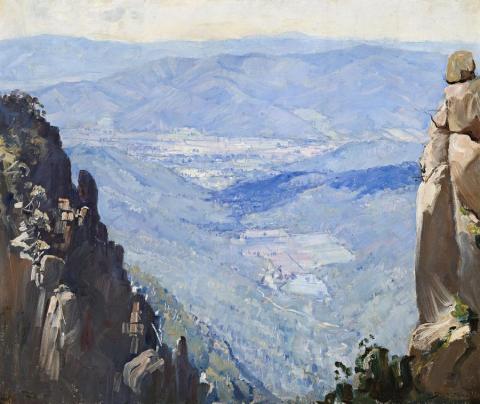MOUNT BUFFALO, c.1914
ARTHUR STREETON
oil on canvas
63.5 x 76.0 cm
signed lower right: A STREETON
Sir Chester and Lady Manifold collection, Victoria
Leonard Joel, Melbourne, 24 July 1985, lot 140
Rogowski collection, Melbourne
Leonard Joel, Melbourne, 23 February 1998, lot 25
Estate of a private collection, Melbourne
The Royal Institute of Oil Painters, London, possibly 1915, cat. 24 (label attached verso)
Clemente, C., Australian Watercolours 1802–1926, National Gallery of Victoria, Melbourne, 1991
Eagle, M., The Oil Paintings of Arthur Streeton in the National Gallery of Australia, National Gallery of Australia, Canberra, 1994, p. 159 (illus.)
Buffalo Mountains, oil on canvas, 76.5 x 64.0 cm, collection of the Castlemaine Art Gallery and Historical Museum, Victoria, in The Arthur Streeton Catalogue, self published, Melbourne, 1935, cat. 529 (as 'Valley, from Bent's Lookout', c1913–14)
Valley, from Bent's Lookout, c1913–14, watercolour, 54.0 x 36.8 cm, collection of the National Gallery of Victoria, Melbourne
Blue Depths, 1915–17, oil on canvas 121.5 x 150 cm, exhibited Royal Academy, London, 1915, private collection
When Arthur Streeton made a return visit to Australia in 1914, he visited Melbourne and Sydney for exhibitions, and in November painted at Mount Buffalo on Victoria's Great Dividing Range. On the tenth of December, at the Athenaeum Hall in Melbourne, he exhibited 'the results of his recent visit to Mount Buffalo, when either in water or oil he captured many of the well-known scenes familiar to tourists'.1 The exhibition was opened by Madam Melba, who described herself as 'one of the greatest admirers of Mr Streeton's work'.2 In the absence of a traced catalogue, the Argus review tells of some fourteen works, including Lilac, Blue and Gold and View from Bent's Look-out. 'In the most of them [it was reported, Streeton] has succeeded in conveying, not only the immense distances, but the translucent atmosphere through which they are generally seen, and this he does by brush passages that never falter, and contain a world of meaning.'3 As was his habit, Streeton chose a particular scenic spot, Bent's Lookout, from which to paint dramatic views of Northcote Crevasse, as seen in our Mount Buffalo, c1914. On Streeton's return to England in early 1915, later that year he exhibited the grand view, Blue Depths, c1915-17, at London's Royal Academy.4 Large in scale, it heralded the monumental in his approach to landscape painting, a feature of his Grampians and later paintings.
Taken from the same scenic spot as our painting, Blue Depths, is a closely related work, the two views differing only in as much as Streeton had taken a step forwards for the larger work. In Mount Buffalo Streeton encompasses a wider, even more panoramic view, retaining all the drama of the scene. The play of foreground verticals against distant horizontals emphasises the perpendicularity of the drop. The close up view of the rocks increases the precipitous feeling, all abruptly falling away, with the spread of valley and landscape below enveloped in the heat haze of late spring. As Mount Buffalo was exhibited with London's Royal Institute of Oil Painters, it is possible that Streeton referred to it in London, together with a number of sketches, for the painting of Blue Depths. Back in Australia, in March 1920 Blue Depths, together with View from Mt Buffalo and On Mt Buffalo were exhibited in Streeton's solo exhibition at the Victorian Artists' Society Gallery. These three specially chosen paintings were exhibited among many works of the Western Front, painted when he was an Official War Artist during in France 1918. As the above View from Mount Buffalo and our painting are the same size, perhaps they are the one and same work.
1.'Art Exhibition', The Argus, Melbourne, 10 December 1914, p. 6
2.'Mr Streeton's Pictures', The Argus, Melbourne, 11 December 1914, p. 9
3. The Argus, Melbourne, 10 December 1914, p. 6
4. Illustrated in Smith, G., Arthur Streeton 1867-1943, National Gallery of Victoria, Melbourne, 1995, p. 155
DAVID THOMAS
